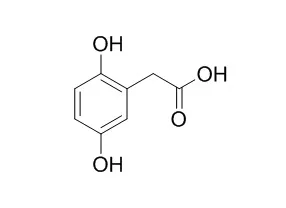| In vitro: |
| Ann Clin Biochem. 2015 Sep;52(Pt 5):597-605. | | Serum markers in alkaptonuria: simultaneous analysis of homogentisic acid, tyrosine and nitisinone by liquid chromatography tandem mass spectrometry.[Pubmed: 25628464] | Alkaptonuria is a rare debilitating autosomal recessive disorder of tyrosine metabolism, where deficiency of homogentisate 1,2-dioxygenase results in increased Homogentisic acid. Homogentisic acid is deposited as an ochronotic pigment in connective tissues, especially cartilage, leading to a severe early onset form of osteoarthritis, increased renal and prostatic stone formation and hardening of heart vessels. Treatment with the orphan drug, nitisinone, an inhibitor of 4-hydroxyphenylpyruvate dioxygenase has been shown to reduce urinary excretion of Homogentisic acid.
METHODS AND RESULTS:
A reverse phase liquid chromatography tandem mass spectrometry method has been developed to simultaneously analyse serum Homogentisic acid, tyrosine and nitisinone. Using matrix-matched calibration standards, two product ion transitions were identified for each compound (Homogentisic acid, tyrosine, nitisinone) and their respective isotopically labelled internal standards ((13)C6-Homogentisic acid, d2-tyrosine, (13)C6-nitisinone). Intrabatch accuracy was 94-108% for Homogentisic acid, 95-109% for tyrosine and 89-106% for nitisinone; interbatch accuracy (n = 20) was 88-108% for Homogentisic acid, 91-104% for tyrosine and 88-103% for nitisinone. Precision, both intra- and interbatch were <12% for Homogentisic acid and tyrosine, and <10% for nitisinone. Matrix effects observed with acidified serum were normalized by the internal standard (<10% coefficient of variation). Homogentisic acid, tyrosine and nitisinone proved stable after 24 h at room temp, three freeze-thaw cycles and 24 h at 4℃.
CONCLUSIONS:
The assay was linear to 500μmol/L Homogentisic acid, 2000μmol/L tyrosine and 10μmol/L nitisinone; increased range was not required for clinical samples and no carryover was observed. | | Clin Biochem. 2014 May;47(7-8):640-7. | | Interferences of homogentisic acid (HGA) on routine clinical chemistry assays in serum and urine and the implications for biochemical monitoring of patients with alkaptonuria.[Pubmed: 24373924] | We have assessed the effect of elevated concentrations of Homogentisic acid (HGA) as in alkaptonuria (AKU), on a range of routine chemistry tests in serum and urine.
METHODS AND RESULTS:
Homogentisic acid was added to pooled serum and a range of assays was analysed with Roche Modular chemistries. Effects on urine were assessed by diluting normal urine with urine from a patient with AKU, adding Homogentisic acid to urine and after lowering output of urinary Homogentisic acid with nitisinone treatment. Serum enzymatic creatinine showed 30% negative interference with 100μmol/L Homogentisic acid and >50% at 400μmol/L. Serum urate 100 to 480μmol/L was reduced up to 20% at 100 and to 50% with 400μmol/L Homogentisic acid. Serum cholesterol between 3 and 11mmol/L was reduced by 0.5mmol/L with 400μmol/L Homogentisic acid. Urine enzymatic creatinine and urate with >2mmol/L Homogentisic acid showed concentration dependent negative interference up to 80%. A positive interference in urine total protein by benzethonium turbidometric assay was observed, with 10mmol/L Homogentisic acid equivalent to 1g/L protein. Jaffe creatinine, Na, K, Cl, Mg, Ca, phosphate, ALT, GGT, ALP activities and urea in serum and or urine were not affected by increases in Homogentisic acid.
CONCLUSIONS:
To avoid interferences by Homogentisic acid in alkaptonuria concentration of Homogentisic acid should be established before samples are assayed with peroxidase assays and benzethonium urine protein. |
|






 Cell. 2018 Jan 11;172(1-2):249-261.e12. doi: 10.1016/j.cell.2017.12.019.IF=36.216(2019)
Cell. 2018 Jan 11;172(1-2):249-261.e12. doi: 10.1016/j.cell.2017.12.019.IF=36.216(2019) Cell Metab. 2020 Mar 3;31(3):534-548.e5. doi: 10.1016/j.cmet.2020.01.002.IF=22.415(2019)
Cell Metab. 2020 Mar 3;31(3):534-548.e5. doi: 10.1016/j.cmet.2020.01.002.IF=22.415(2019) Mol Cell. 2017 Nov 16;68(4):673-685.e6. doi: 10.1016/j.molcel.2017.10.022.IF=14.548(2019)
Mol Cell. 2017 Nov 16;68(4):673-685.e6. doi: 10.1016/j.molcel.2017.10.022.IF=14.548(2019)